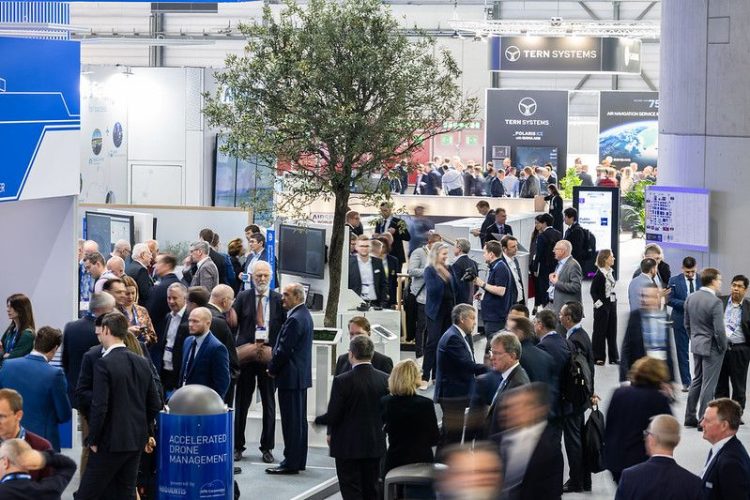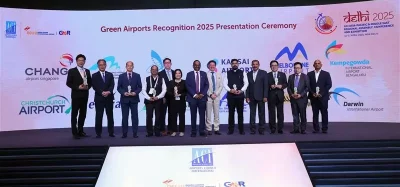Airspace World responds to ATM challenges
- Like
- Digg
- Del
- Tumblr
- VKontakte
- Buffer
- Love This
- Odnoklassniki
- Meneame
- Blogger
- Amazon
- Yahoo Mail
- Gmail
- AOL
- Newsvine
- HackerNews
- Evernote
- MySpace
- Mail.ru
- Viadeo
- Line
- Comments
- Yummly
- SMS
- Viber
- Telegram
- Subscribe
- Skype
- Facebook Messenger
- Kakao
- LiveJournal
- Yammer
- Edgar
- Fintel
- Mix
- Instapaper
- Copy Link
Posted: 23 April 2024 | CANSO | No comments yet
Airspace World 2024 offered rich content on every aspect of air traffic management (ATM) operations. With some 200 exhibitors and five theatres, innovation and inspiration was never more than a few steps away.


Airspace World 2024 offered rich content on every aspect of air traffic management (ATM) operations. With some 200 exhibitors and five theatres, innovation and inspiration was never more than a few steps away.
All the major topics were debated at length – from sustainability to artificial intelligence (AI) and advanced air mobility (AAM) – and exhibitors displayed the solutions that could help air navigation service providers (ANSPs) overcome the industry’s critical challenges.
Sustainability
Aviation is committed to net zero carbon emissions by 2050, for example, and there are enormous pressures to reduce CO2 from customers through to governments. At Airspace World, various presentations and exhibitors explained the Scopes, which were laid down in the Greenhouse Gas Protocol:
• Scope 1 – direct emissions, such as facilities and vehicles.
• Scope 2 – indirect emissions, such as energy supply source
• Scope 3 – other indirect emissions throughout the supply chain, such as aircraft emissions.
Throughout, the point was made that a holistic approach involving all stakeholders is therefore essential because emissions can occur at any point in the supply chain. Across the event, it was clear that roadmaps, relevant accreditations and certifications and a sustainability dashboard are all useful tools for identifying any gaps and plotting progress.
Sustainability is also dependent on being more efficient. Although traffic is predicted to almost double by 2050, no such increase is suggested for airports or air traffic management in terms of staff or other relevant parameters. Greater efficiency is therefore the only viable way forward.
Improvements, such as trajectory-based operations or contrail avoidance, will be vital. The question is how to implement procedural improvements when they rely on huge amounts of real time data.
Artificial intelligence
The hope is that artificial intelligence (AI) will make this possible. Defining AI is difficult but at Airspace World most content was predicated on AI being anything that can support a human in his or her tasks or indeed undertake a task normally performed by a human.
The event made it clear that full automation that is reliant on AI is not yet appropriate. For many years to come, AI’s role will be in decision support for air traffic controllers and other staff. This will build the trust and experience that will be essential to embracing the full potential of AI. The technology can also be used for monitoring and analysing. AI is excellent at identifying patterns that humans wouldn’t see, and this can go a long way to making the skies safer and more efficient.
Areas where AI can make an initial impact include weather prediction, digital twin scenarios, predictive maintenance and training. When getting a controller from “street to seat”, for example, AI can look at a student’s progress to ensure simulations are tailored to cover any possible shortfalls in knowledge.
Markus Klopf, Head of ATM Portfolio and International Affairs at Frequentis clarified that “AI’s future in ATM will deliver benefit in four main areas: productivity, performance, resilience and prediction, and digital immunity”.
One presentation noted that AI is already playing a role mirroring time-based separation at London Heathrow. It was revealed that, generally, AI takes a safer approach than is absolutely necessary, but this is helping to inform the parameters that need to be put in place.
One of the biggest challenges ahead is certification. EUROCAE are working on a standard that will align Europe with the United States and also connect with other parts of the world. This work will be a cornerstone of AI development and a key enabler for progress.
Overall, however, Airspace World demonstrated AI’s positive impact on ATM. It will enhance productivity, performance and resilience while providing the platform for future developments.
Advanced air mobility
Advanced air mobility (AAM) was also high on the agenda at Airspace World. AAM will see thousands of new vehicles entering civil airspace, making automation essential. After all, automation in aviation is not new and most civil flights carrying hundreds of passengers are flown automatically for most of the journey.
But to share civil airspace, it will be necessary to show that automated flights – whether they are drones or air taxis – will not create any conflicts. Demonstrations are difficult to organise, however, involving permissions, airspace closures, extensive data gathering and analytics.
But presentations and exhibitors alike highlighted that AAM is designing an architecture that is predicated on automation and so it won’t be a case of reinventing the wheel going forward.
Regulations, meanwhile, are a thorny topic that will take time to perfect. Already, there is a lot of blurring with data privacy rules and artificial intelligence certification issues adding to the complexity.
One panel concluded that aviation and AAM are not special. Automation is happening everywhere and there are plenty of lessons to be learned, which can – and must – accelerate deployment of automated AAM.
Tomorrow’s voices
Airspace World’s final day was especially strong. Rather than easing down, the event accelerated toward the finish line. The last day was important for the next generation of aviation professionals thanks to the “Tomorrow’s Voices” initiative.
At the “Tomorrow’s Voices – Forum of Next Generation Aviation Professionals”
panel, for example, recent graduates and students who participated in the three-day event shared their insights. This informative panel gave a voice to the aspiring aviation professionals, fostering an open dialogue about their experiences and key takeaways.
What will the skies look like when these young professionals take on leadership roles? Airspace World suggested some possible answers:
• There will be a modal shift in transportation. Although human pilots may initially be involved in some advanced air mobility (AAM) flights, eventually uncrewed operations at scale will be routine.
• Airspace will be integrated from space to ground. This will not only be about what is happening below 500ft but also look at procedures above the current flight levels.
• Regulations will evolve to include digital instrument Flight Rules (IFR). AAM will probably use visual flight rules (VFR) initially, then move to IFR before digital IFR becomes commonplace.
• Infrastructure will become increasingly complex and abundant with vertiports springing up across cities.
• Air navigation service providers (ANSPs) will accelerate and complete their digitalisation work to integrate all airspace users safely and seamlessly.
In summary, Airspace World helped the entire aviation community learn today about the needs of tomorrow. Its speakers and exhibitors stepped up to the challenge to keep the attendees engaged and informed.
“We are delighted to have been able to take part in Airspace World for another year, in partnership with the Direction Generale de l’Aviation Civile,” noted France Aviation Civile Services on social media. “Like every year, this major event brings together the main players in the world of ATM and offers us some rewarding encounters that sometimes lead to great projects. It’s always a pleasure to meet up with our partners and experts.”
We look forward to seeing everyone at Airspace World 2025, 13-15 May, in Lisbon, Portugal.
Related topics
Air traffic control/management (ATC/ATM), Airside operations, Airspace modernisation, Digital transformation, Sustainability


















